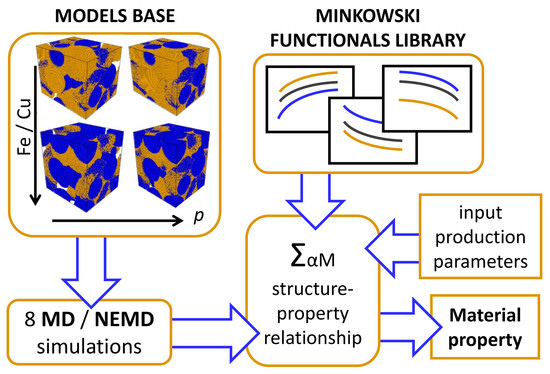Effect of Cold-Sintering Parameters on Structure, Density, and Topology of Fe–Cu Nanocomposites
Abstract
1. Introduction
2. Materials and Methods
2.1. Bimetallic Nanoparticles Powder Model
2.2. Potentials
2.3. Cold-Sintering Model
2.4. Advantages, Assumptions, and Drawbacks of the Model and Method
2.5. Methods of Structural and Topological Analysis
2.5.1. Atomic Structure Analysis
2.5.2. Topological Analysis
- substance type, possible values (“phases”): iron, copper or vacuum (nanopore);
- lattice type determined from the a-CNA results, possible values (“phases”): bcc, fcc, hcp, or disordered (amorphous or surface atoms).
3. Results and Discussion
3.1. Density and Porosity of Cold-Sintered Fe–Cu
3.2. Atomic Structure of Fe–Cu Compacts
3.2.1. Quasi-bcc Copper Phase
3.2.2. The Disordered and Hcp Phases
3.3. Topological Analysis
3.3.1. Minkowski Functionals
3.3.2. Pairwise Interfaces
3.3.3. Mean Phase Thickness
3.4. A New Tool for Computer-Aided Design of Fe–Cu Nanocomposites
4. Conclusions
Supplementary Materials
Author Contributions
Funding
Acknowledgments
Conflicts of Interest
References
- Luechinger, N.A.; Grass, R.N.; Athanassiou, E.K.; Stark, W.J. Bottom-up fabrication of metal/metal nanocomposites from nanoparticles of immiscible metals. Chem. Mater. 2009, 22, 155–160. [Google Scholar] [CrossRef]
- Beloshenko, V.A.; Dmitrenko, V.Y.; Chishko, V.V. Modifying the structure and properties of Cu-Fe composites by the methods of pressure formation. Phys. Met. Metallogr. 2015, 116, 456–466. [Google Scholar] [CrossRef]
- Verhoeven, J.D.; Chueh, S.C.; Gibson, E.D. Strength and conductivity of in situ Cu-Fe alloys. J. Mater. Sci. 1989, 24, 1748–1752. [Google Scholar] [CrossRef]
- Ma, L.C.; Zhang, J.M.; Xu, K.W. Magnetic and electronic properties of Fe/Cu multilayered nanowires: A first-principles investigation. Phys. E Low-Dimens. Syst. Nanostruct. 2013, 50, 1–5. [Google Scholar] [CrossRef]
- Kana, T.; Zouhar, M.; Cerny, M.; Sob, M. Ab initio study of the theoretical strength and magnetism of the Fe-Pd, Fe-Pt and Fe-Cu nanocomposites. J. Magn. Magn. Mater. 2019, 469, 100–107. [Google Scholar] [CrossRef]
- Wang, X.; Ru, H. Effect of Lubricating Phase on Microstructure and Properties of Cu–Fe Friction Materials. Materials 2019, 12, 313. [Google Scholar] [CrossRef]
- Kolesnikov, S.V. Self-organization of iron-atom nanostructures in the first layer of the (100) copper surface. JETP Lett. 2014, 99, 286–289. [Google Scholar] [CrossRef]
- Kolesnikov, S.V.; Klavsyuk, A.L.; Saletsky, A.M. Fe and Co nanostructures embedded into the Cu (100) surface: Self-Organization and magnetic properties. J. Exp. Theor. Phys. 2015, 121, 616–622. [Google Scholar] [CrossRef]
- Kuncser, V.; Mustata, I.; Lungu, C.P.; Lungu, A.M.; Zaroschi, V.; Keune, W.; Sahoo, B.; Stromberg, F.; Walterfang, M.; Ion, L.; et al. Fe–Cu granular thin films with giant magnetoresistance by thermionic vacuum arc method: Preparation and structural characterization. Surf. Coat. Technol. 2005, 200, 980–983. [Google Scholar] [CrossRef]
- Gutmanas, E.Y.; Rabinkin, A.; Roitberg, M. Cold sintering under high pressure. Scr. Metall. 1979, 13, 11–15. [Google Scholar] [CrossRef]
- Gutmanas, E.Y. Cold Sintering Under High Pressure—Mechanisms and Application. Powder Metall. Int. 1983, 15, 129–132. [Google Scholar]
- Gutmanas, E.Y.; Trusov, L.I.; Gotman, I. Consolidation, microstructure and mechanical properties of nanocrystalline metal powders. Nanostruct. Mater. 1994, 4, 893–901. [Google Scholar] [CrossRef]
- Bai, J.G.; Zach, Z.Z.; Calata, J.N.; Guo-Quan, L. Components and packaging technologies. IEEE Trans. 2006, 29, 589–593. [Google Scholar]
- Nicula, R.; Luthen, F.; Stir, M.; Nebe, B.; Burkel, E. Spark plasma sintering synthesis of porous nanocrystalline titanium alloys for biomedical applications. Biomol. Eng. 2007, 24, 564–567. [Google Scholar] [CrossRef] [PubMed]
- Zou, L.; Chen, F.; Wang, H.; Shen, Q.; Lavernia, E.J.; Zhang, L. Influence of Porosity on Mechanical Behavior of Porous Cu Fabricated via De-Alloying of Cu–Fe Alloy. Met. Mater. Int. 2019, 25, 83–93. [Google Scholar] [CrossRef]
- Cheng, B.; Ngan, A.H. The sintering and densification behaviour of many copper nanoparticles: A molecular dynamics study. Comput. Mater. Sci. 2013, 74, 1–11. [Google Scholar] [CrossRef]
- Tavakol, M.; Mahnama, M.; Naghdabadi, R. Shock wave sintering of Al/SiC metal matrix nano-composites: A molecular dynamics study. Comput. Mater. Sci. 2016, 125, 255–262. [Google Scholar] [CrossRef]
- Mayer, A.E.E.; Al-Sandoqachi, M.K.A. Molecular-dynamic study of the size effect in the compacting of monodisperse aluminum nanopowder. Chelyabinskiy Fiz.-Mat. Zhurnal 2018, 3, 193–201. [Google Scholar] [CrossRef]
- Levchenko, E.V.; Evteev, A.V.; Lorscheider, T.; Belova, I.V.; Murch, G.E. Molecular dynamics simulation of alloying in an Al-coated Ti nanoparticle. Comput. Mater. Sci. 2013, 79, 316–325. [Google Scholar] [CrossRef]
- Grammatikopoulos, P.; Sowwan, M.; Kioseoglou, J. Computational modeling of nanoparticle coalescence. Adv. Theory Simul. 2019, 2, 1900013. [Google Scholar] [CrossRef]
- Tsukanov, A.A.; Lozhkomoev, A.S.; Lerner, M.I.; Gotman, I.; Gutmanas, E.Y.; Psakhie, S.G. Molecular dynamics study of bimetallic Fe–Cu Janus nanoparticles formation by electrical explosion of wires. Philos. Mag. 2019, 99, 1121–1138. [Google Scholar] [CrossRef]
- Arns, C.H.; Knackstedt, M.A.; Mecke, K.R. Characterisation of irregular spatial structures by parallel sets and integral geometric measures. Colloids Surf. A Physicochem. Eng. Asp. 2004, 241, 351–372. [Google Scholar] [CrossRef]
- Armstrong, R.T.; McClure, J.E.; Robins, V.; Liu, Z.; Arns, C.H.; Schluter, S.; Berg, S. Porous media characterization using Minkowski functionals: Theories, applications and future directions. Transp. Porous Media 2018, 130, 305–335. [Google Scholar] [CrossRef]
- Gilmanov, R.R.; Kalyuzhnyuk, A.V.; Taimanov, I.A.; Yakovlev, A.A. Topological Characteristics of Digital Models of Geological Core. In Proceedings of the International Cross-Domain Conference for Machine Learning and Knowledge Extraction, Hamburg, Germany, 27–30 August 2018; Springer: Cham, Switzerland, 2018; pp. 273–281. [Google Scholar] [CrossRef]
- Vogel, H.-J.; Weller, U.; Schluter, S. Quantification of soil structure based on Minkowski functions. Comput. Geosci. 2010, 36, 1236–1245. [Google Scholar] [CrossRef]
- Salerno, M.; Stępniowski, W.J.; Cieślak, G.; Norek, M.; Michalska-Domańska, M.; Karczewski, K.; Chilimoniuk, P.; Polkowski, W.; Jóźwik, P.; Bojar, Z. Advanced image analysis of the surface pattern emerging in Ni3Al intermetallic alloys on anodization. Front. Mater. 2016, 3, 34. [Google Scholar] [CrossRef]
- Jafari, A.; Alipour, R.; Ghoranneviss, M.; Ramezani, A.H. Specialized Study on Morphological Features of Tungsten Carbide Thin Film Synthesis by HFCVD. J. Inorg. Organomet. Polym. Mater. 2016, 26, 384–393. [Google Scholar] [CrossRef]
- Gorodetskyi, O.; Hutter, M.; Geers, M.G. Detecting precursors of localization by strain-field analysis. Mech. Mater. 2017, 110, 84–97. [Google Scholar] [CrossRef]
- Nagarajan, M.B.; De, T.; Lochmuller, E.M.; Eckstein, F.; Wismuller, A. Using anisotropic 3D Minkowski functionals for trabecular bone characterization and biomechanical strength prediction in proximal femur specimens. In Proceedings of the Medical Imaging 2014: Biomedical Applications in Molecular, Structural, and Functional Imaging, San Diego, CA, USA, 15–20 February 2014; International Society for Optics and Photonics: San Diego, CA, USA, 2014; Volume 9038, p. 903820. [Google Scholar] [CrossRef]
- Hadwiger, H. Vorlesungen Uber Inhalt, Oberflache und Isoperimetrie; Springer: Berlin/Heidelberg, Germany, 1975. [Google Scholar]
- Wilkinson, M.D.; Dumontier, M.; jan Aalbersberg, I.J.; Appleton, G.; Axton, M.; Baak, A.; Blomberg, N.; Boiten, J.-W.; da Silva Santos, L.B.; Bourne, P.E.; et al. The FAIR Guiding Principles for scientific data management and stewardship. Sci. Data 2016, 3, 160018. [Google Scholar] [CrossRef]
- Daw, M.S.; Baskes, M.I. Embedded-atom method: Derivation and application to impurities, surfaces, and other defects in metals. Phys. Rev. B 1984, 29, 6443–6453. [Google Scholar] [CrossRef]
- Bonny, G.; Pasianot, R.C.; Castin, N.; Malerba, L. Ternary Fe-Cu-Ni many-body potential to model reactor pressure vessel steels: First validation by simulated thermal annealing. Philos. Mag. 2009, 89, 3531–3546. [Google Scholar] [CrossRef]
- Mendelev, M.I.; Han, S.; Srolovitz, D.J.; Ackland, G.J.; Sun, D.Y.; Asta, M. Development of new interatomic potentials appropriate for crystalline and liquid iron. Philos. Mag. 2003, 83, 3977–3994. [Google Scholar] [CrossRef]
- Mishin, Y.; Mehl, M.J.; Papaconstantopoulos, D.A.; Voter, A.F.; Kress, J.D. Structural stability and lattice defects in copper: Ab initio, tight-binding, and embedded-atom calculations. Phys. Rev. B 2001, 63, 224106. [Google Scholar] [CrossRef]
- Plimpton, S. Fast parallel algorithms for short-range molecular dynamics. J. Comput. Phys. 1995, 117, 1–19. [Google Scholar] [CrossRef]
- Plimpton, S.; Crozier, P.; Thompson, A. LAMMPS-large-scale atomic/molecular massively parallel simulator. Sandia Natl. Lab. 2007, 18, 43. [Google Scholar]
- Voevodin, V.V.; Antonov, A.S.; Nikitenko, D.A.; Shvets, P.A.; Sobolev, S.I.; Sidorov, I.Y.; Stefanov, K.S.; Voevodin, V.V.; Zhumatiy, S.A. Supercomputer Lomonosov-2: Large Scale, Deep Monitoring and Fine Analytics for the User Community. Supercomput. Front. Innov. 2019, 6, 4–11. [Google Scholar] [CrossRef]
- Adinets, A.V.; Bryzgalov, P.A.; Voevodin, V.V.; Zhumatii, S.A.; Nikitenko, D.A.; Stefanov, K.S. Job digest: An approach to dynamic analysis of job characteristics on supercomputers. Numer. Methods Program. Adv. Comput. 2012, 13, 160–166. Available online: https://num-meth.srcc.msu.ru/english/zhurnal/tom_2012/pdf/v13r221.pdf (accessed on 10 November 2019).
- Zacharov, I.; Arslanov, R.; Gunin, M.; Stefonishin, D.; Pavlov, S.; Panarin, O.; Maliutin, A.; Rykovanov, S.; Fedorov, M. ‘Zhores’—Petaflops supercomputer for data-driven modeling, machine learning and artificial intelligence installed in Skolkovo Institute of Science and Technology. Open Eng. 2019, 9, 512–520. [Google Scholar] [CrossRef]
- Buffat, P.; Borel, J.P. Size effect on the melting temperature of gold particles. Phys. Rev. A 1976, 13, 2287–2298. [Google Scholar] [CrossRef]
- Lerner, M.I.; Psakhie, S.G.; Lozhkomoev, A.S.; Sharipova, A.F.; Pervikov, A.V.; Gotman, I.; Gutmanas, E.Y. Fe–Cu nanocomposites by high pressure consolidation of powders prepared by electric explosion of wires. Adv. Eng. Mater. 2018, 20, 1701024. [Google Scholar] [CrossRef]
- Afify, N.D.; Salem, H.G.; Yavari, A.; El Sayed, T. Consolidation of nanometer-sized aluminum single crystals: Microstructure and defects evolutions. Comput. Mater. Sci. 2014, 85, 306–309. [Google Scholar] [CrossRef]
- Stukowski, A. Structure identification methods for atomistic simulations of crystalline materials. Model. Simul. Mater. Sci. Eng. 2012, 20, 045021. [Google Scholar] [CrossRef]
- Stukowski, A. Visualization and analysis of atomistic simulation data with OVITO–the Open Visualization Tool. Model. Simul. Mater. Sci. Eng. 2009, 18, 015012. [Google Scholar] [CrossRef]
- Legland, D.; Kieu, K.; Devaux, M.F. Computation of Minkowski measures on 2D and 3D binary images. Image Anal. Stereol. 2011, 26, 83–92. [Google Scholar] [CrossRef]
- Blasquez, I.; Poiraudeau, J.F. Efficient processing of Minkowski functionals on a 3D binary image using binary decision diagrams. J. WSCG 2003, 11, 1–8. Available online: https://otik.uk.zcu.cz/bitstream/11025/1669/1/I79.pdf (accessed on 10 November 2019).
- Suzuki, S.; Ishikawa, Y.; Isshiki, M.; Waseda, Y. Native oxide layers formed on the surface of ultra high-purity iron and copper investigated by angle resolved XPS. Mater. Trans. JIM 1997, 38, 1004–1009. [Google Scholar] [CrossRef]
- Wang, Z.Q.; Lu, S.H.; Li, Y.S.; Jona, F.; Marcus, P.M. Epitaxial growth of a metastable modification of copper with body-centered-cubic structure. Phys. Rev. B 1987, 35, 9322. [Google Scholar] [CrossRef]
- Li, H.; Tian, D.; Quinn, J.; Li, Y.S.; Jona, F.; Marcus, P.M. Low-energy electron diffraction and photoemission study of epitaxial films of Cu on Ag {001}. Phys. Rev. B 1991, 43, 6342. [Google Scholar] [CrossRef]
- Goodman, S.R.; Brenner, S.S.; Low, J.R. An FIM-atom probe study of the precipitation of copper from lron-1.4 at. pct copper. Part I: Field-ion microscopy. Metall. Trans. 1973, 4, 2363–2369. [Google Scholar] [CrossRef]
- Fine, M.E.; Liu, J.Z.; Asta, M.D. An unsolved mystery: The composition of bcc Cu alloy precipitates in bcc Fe and steels. Mater. Sci. Eng. A 2007, 463, 271–274. [Google Scholar] [CrossRef]
- Neogi, A.; Mitra, N. A metastable phase of shocked bulk single crystal copper: An atomistic simulation study. Sci. Rep. 2017, 7, 7337. [Google Scholar] [CrossRef]
- Bolesta, A.V.; Fomin, V.M. Molecular dynamics simulation of shock-wave loading of copper and titanium. In AIP Conference Proceedings; AIP Publishing: New York, NY, USA, 2017; Volume 1893, No. 1; p. 020008. [Google Scholar]
- Liu, J.Z.; Van De Walle, A.; Ghosh, G.; Asta, M. Structure, energetics, and mechanical stability of Fe-Cu bcc alloys from first-principles calculations. Phys. Rev. B 2005, 72, 144109. [Google Scholar] [CrossRef]
- Zhou, J.; Averback, R.S.; Bellon, P. Stability and amorphization of Cu–Nb interfaces during severe plastic deformation: Molecular dynamics simulations of simple shear. Acta Mater. 2014, 73, 116–127. [Google Scholar] [CrossRef]
- Sauvage, X.; Renaud, L.; Deconihout, B.; Blavette, D.; Ping, D.H.; Hono, K. Solid state amorphization in cold drawn Cu/Nb wires. Acta Mater. 2001, 49, 389–394. [Google Scholar] [CrossRef]
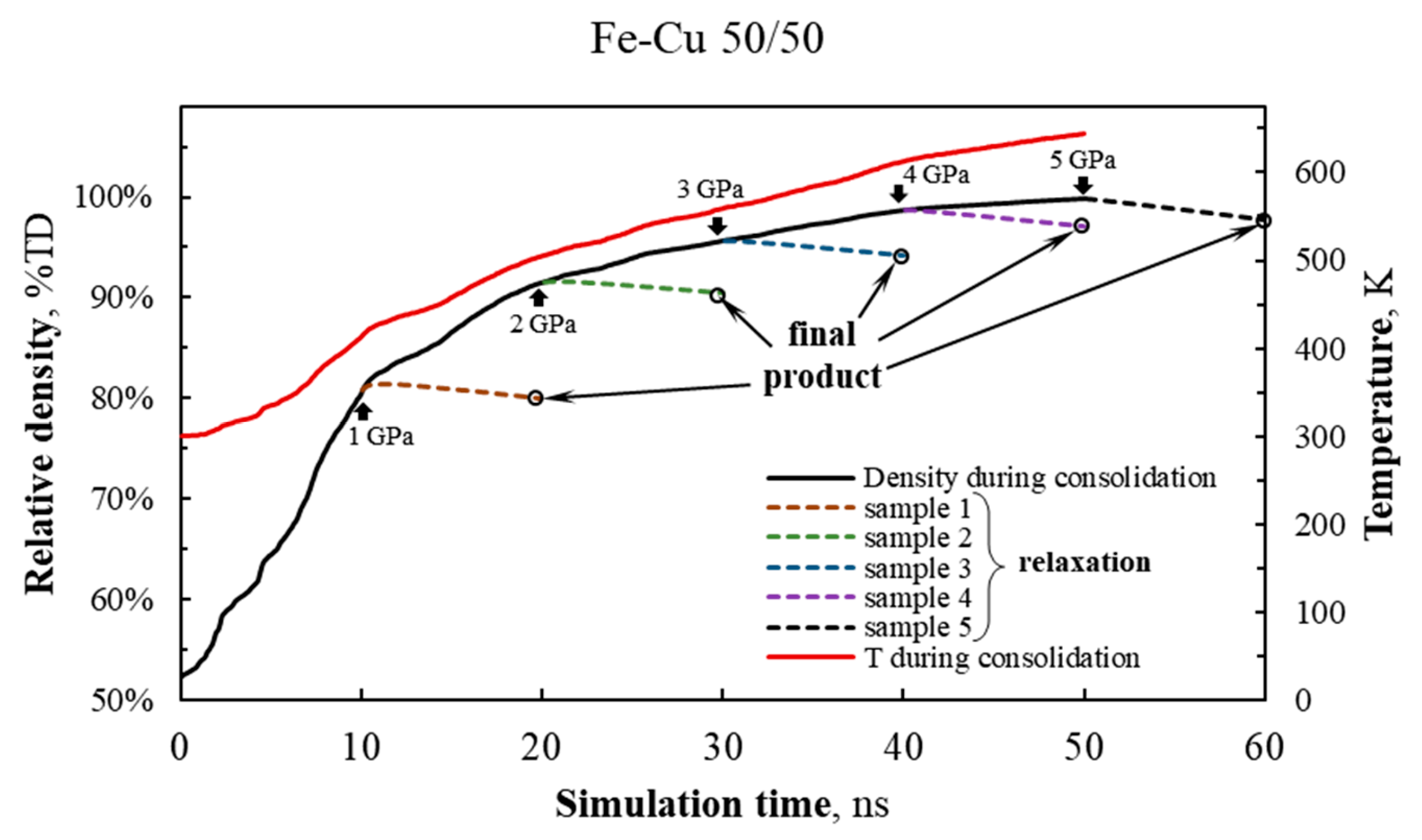

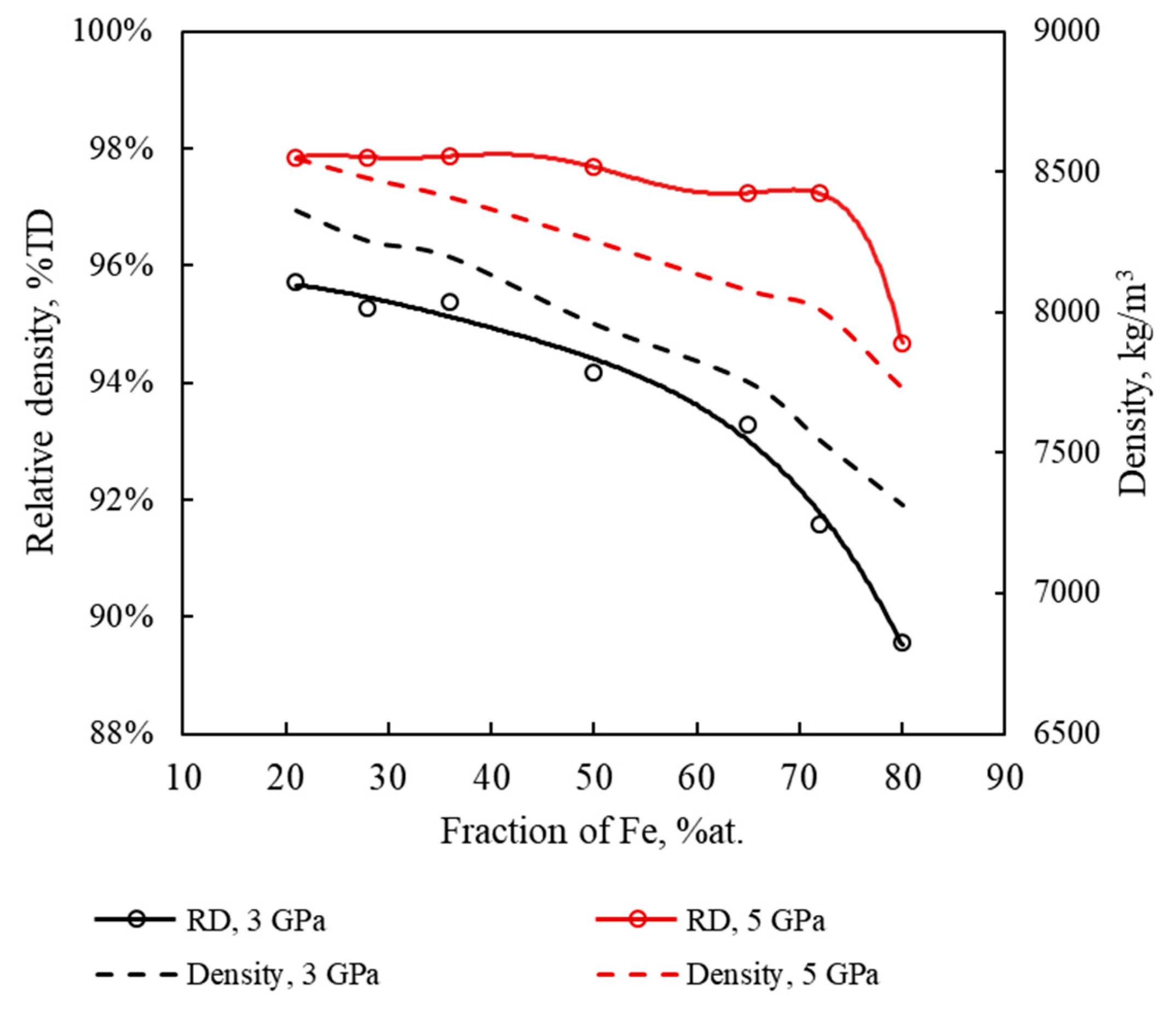
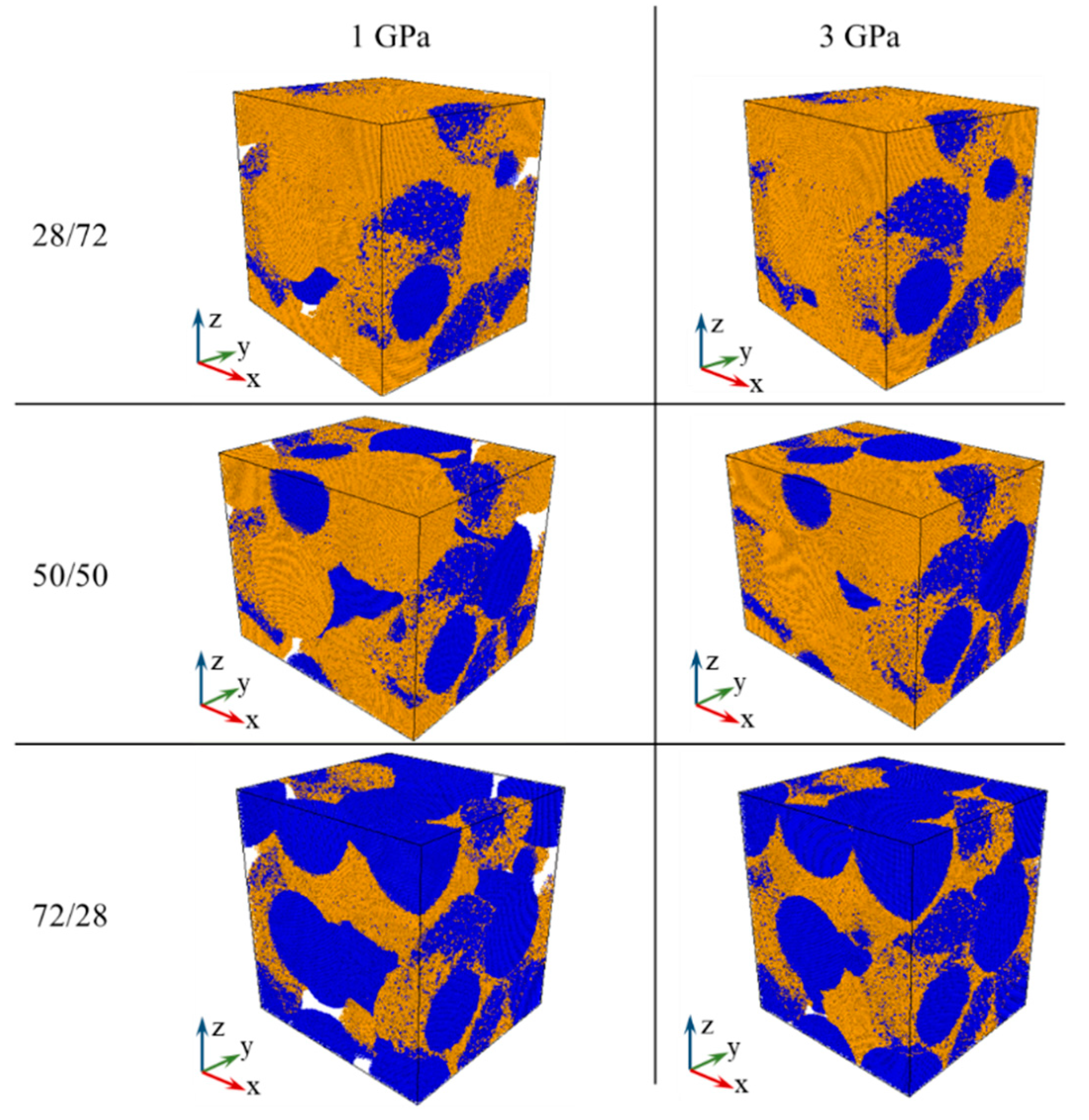

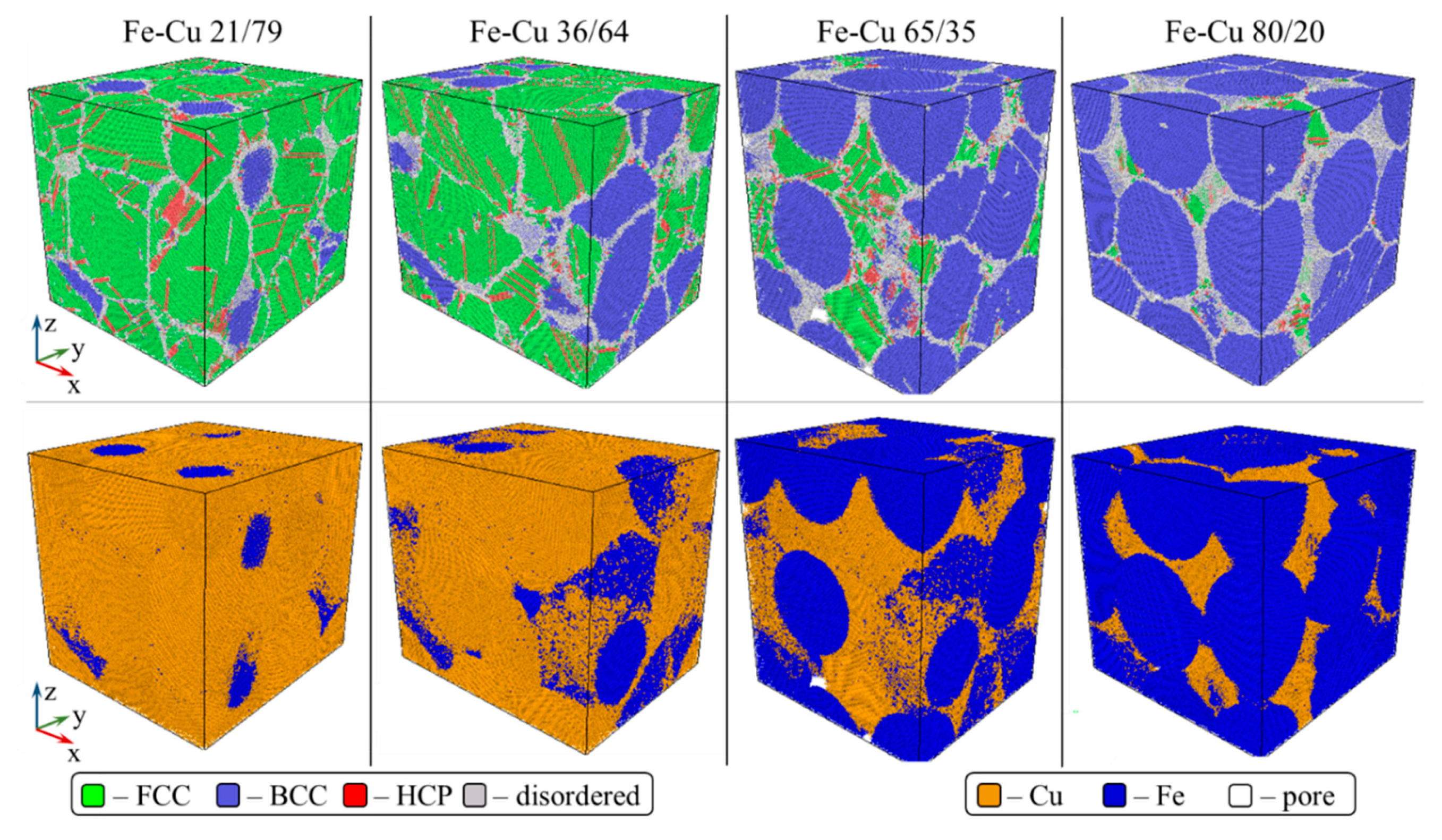
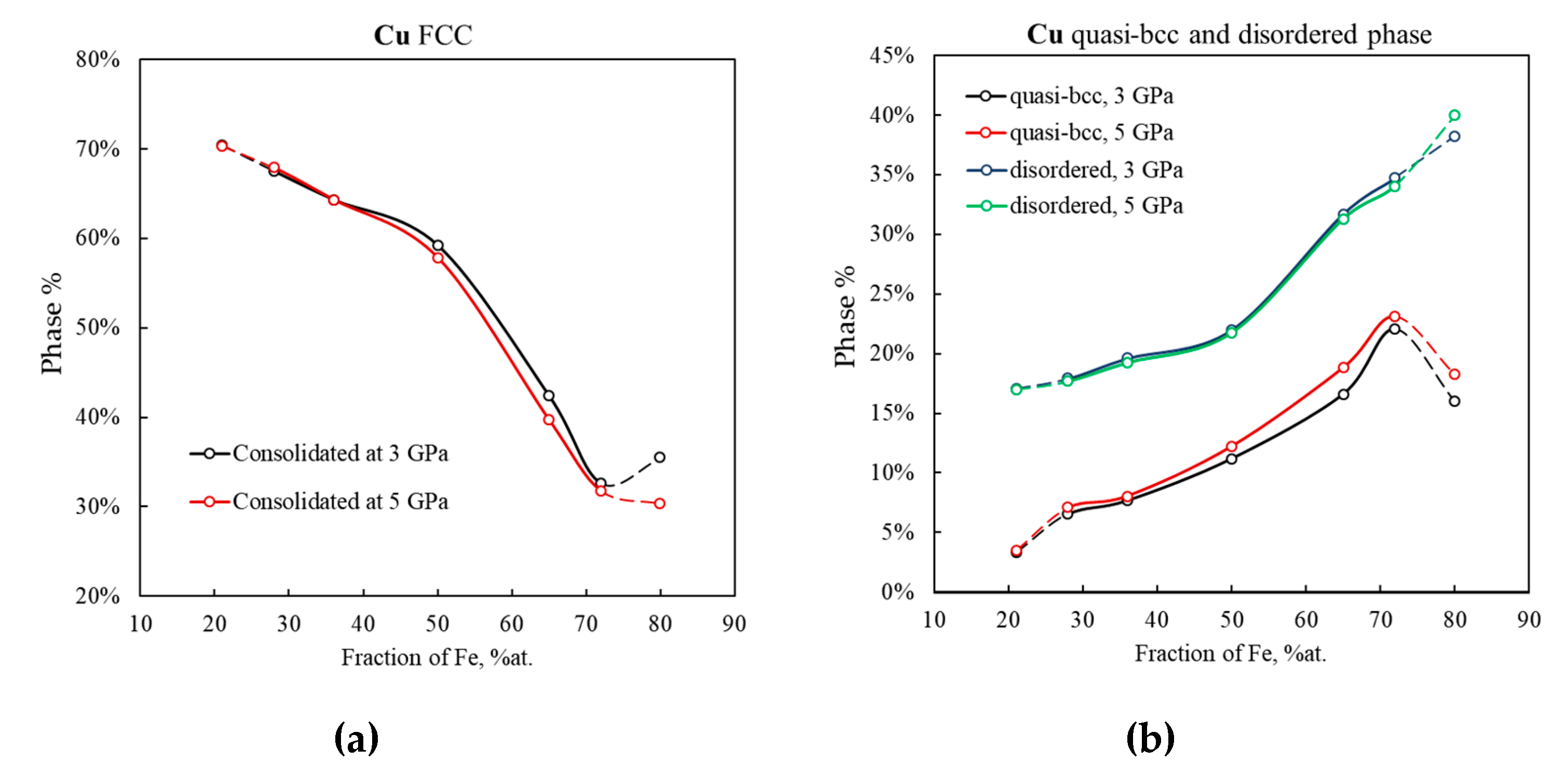
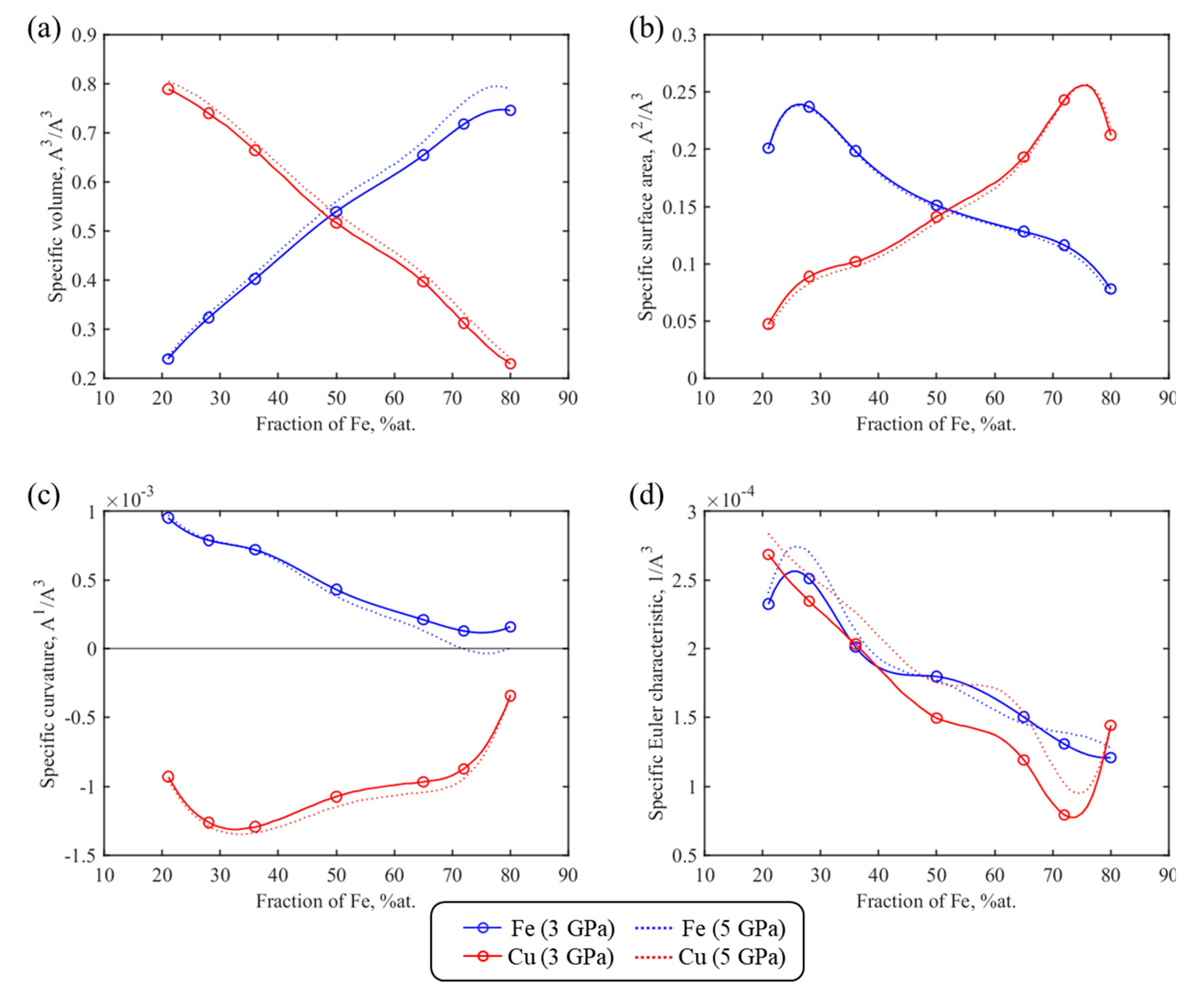
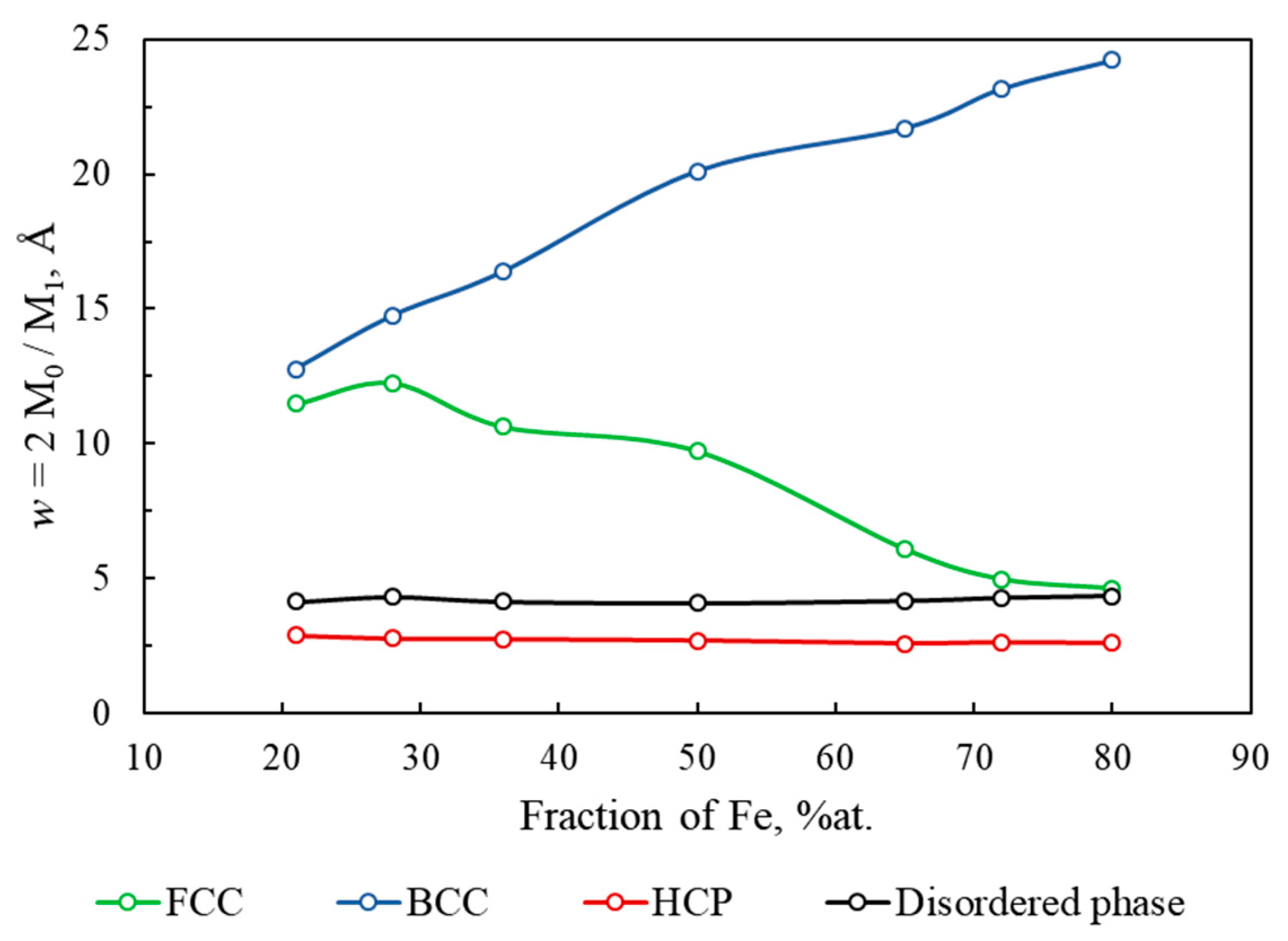
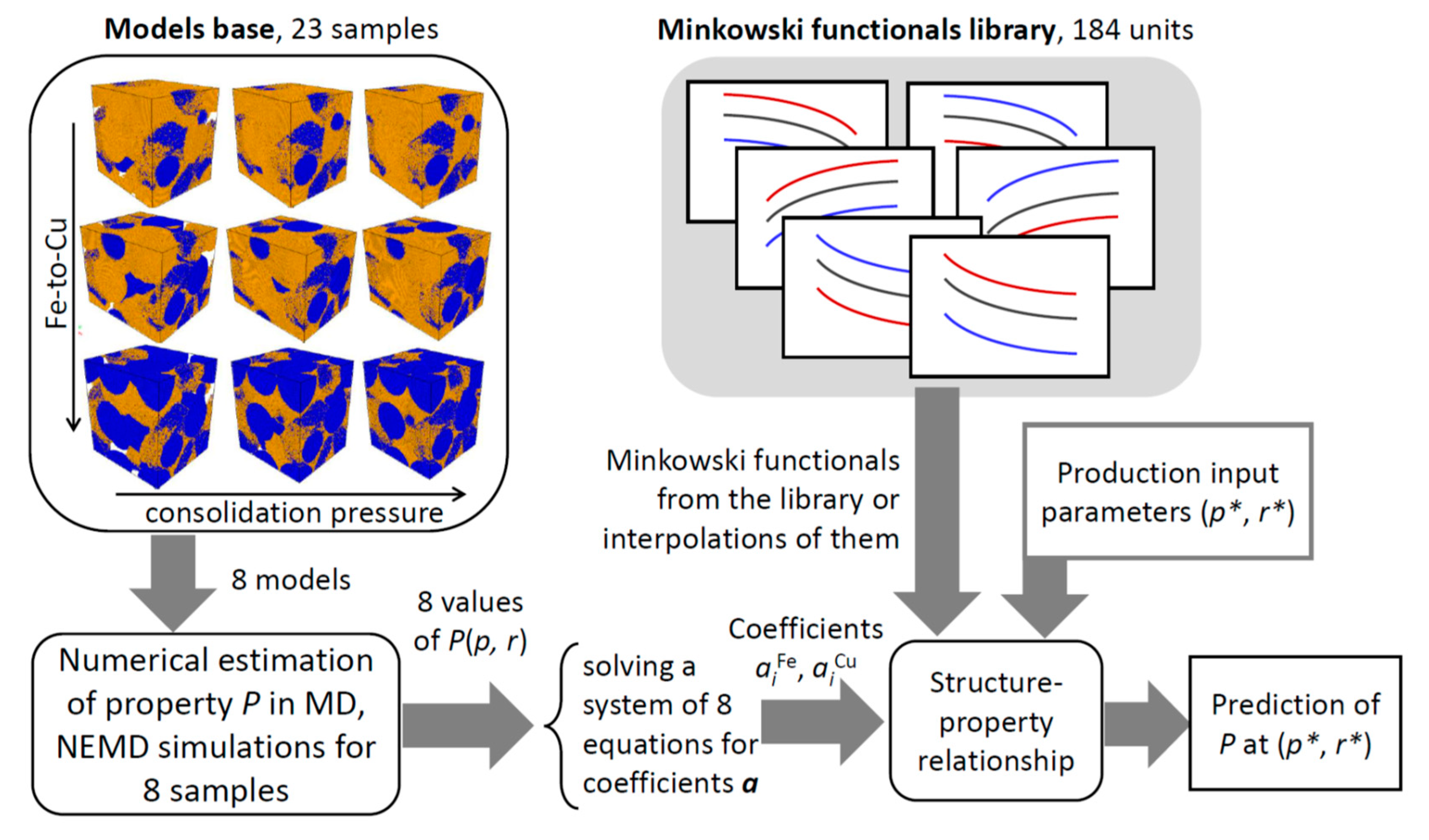
| Code | Particle Type | Atom Count (Particle Diameter, Å) | Fe, at.% | Production Method |
|---|---|---|---|---|
| A | Capped Janus | 87,532 (~125) | 89.0 | Merging a 120 Å Fe nanoparticle with a 60 Å Cu nanoparticle at T = 1500 K |
| B | Partially engulfed Janus with copper crust | 86,150 (~125) | 11.3 | Merging a 60 Å Fe nanoparticle with a 120 Å Cu nanoparticle at T = 1500 K |
| C | Acorn-shaped Janus | 154,364 (~150) | 50.5 | Merging a 120 Å Fe nanoparticle with a 120 Å Cu nanoparticle at T = 1500 K |
| D | Two-hemisphere spherical Janus with copper crust | 154,364 (~150) | 50.5 | Merging a 120 Å Fe nanoparticle with a 120 Å Cu nanoparticle at T = 2000 K |
| E | Spherical Janus with a clear boundary and copper crust | 19,318 (~75) | 50.3 | Collision of monometallic 60 Å nanoparticles at the relative velocity of 20 m/s and initial T0~1680 K |
| F | Spherical Fe (100%) nanoparticle | 151,669 (150) | 100 | Cutting out a 150 Å diameter sphere from a bulk bcc monocrystal with a = 2.855 Å |
| G | Spherical Cu (100%) nanoparticle | 149,621 (150) | 0.0 | Cutting out a 150 Å diameter sphere from a bulk fcc monocrystal with a = 3.615 Å |
| Model Code | Atom Count | Nanopowder Composition | Fe, at.%. | TD, kg/m3 |
|---|---|---|---|---|
| 21/79 | 2 026 742 | A2B2C2DEG8 | 20.7% | 8737 |
| 28/72 | 2 036 228 | A2B2C2D3EG6 | 28.2% | 8665 |
| 36/64 | 2 038 276 | A2B2C2D3EFG5 | 35.6% | 8593 |
| 50/50 | 2 042 372 | A2B2C2D3EF3G3 | 50.4% | 8450 |
| 65/35 | 2 046 468 | A2B2C2D3EF5G | 65.1% | 8308 |
| 72/28 | 2 048 516 | A2B2C2D3EF6 | 72.5% | 8236 |
| 80/20 | 2 043 126 | A2B2C2DEF8 | 79.9% | 8164 |
© 2020 by the authors. Licensee MDPI, Basel, Switzerland. This article is an open access article distributed under the terms and conditions of the Creative Commons Attribution (CC BY) license (http://creativecommons.org/licenses/by/4.0/).
Share and Cite
Tsukanov, A.; Ivonin, D.; Gotman, I.; Gutmanas, E.Y.; Grachev, E.; Pervikov, A.; Lerner, M. Effect of Cold-Sintering Parameters on Structure, Density, and Topology of Fe–Cu Nanocomposites. Materials 2020, 13, 541. https://doi.org/10.3390/ma13030541
Tsukanov A, Ivonin D, Gotman I, Gutmanas EY, Grachev E, Pervikov A, Lerner M. Effect of Cold-Sintering Parameters on Structure, Density, and Topology of Fe–Cu Nanocomposites. Materials. 2020; 13(3):541. https://doi.org/10.3390/ma13030541
Chicago/Turabian StyleTsukanov, Alexey, Dmitriy Ivonin, Irena Gotman, Elazar Y. Gutmanas, Eugene Grachev, Aleksandr Pervikov, and Marat Lerner. 2020. "Effect of Cold-Sintering Parameters on Structure, Density, and Topology of Fe–Cu Nanocomposites" Materials 13, no. 3: 541. https://doi.org/10.3390/ma13030541
APA StyleTsukanov, A., Ivonin, D., Gotman, I., Gutmanas, E. Y., Grachev, E., Pervikov, A., & Lerner, M. (2020). Effect of Cold-Sintering Parameters on Structure, Density, and Topology of Fe–Cu Nanocomposites. Materials, 13(3), 541. https://doi.org/10.3390/ma13030541





